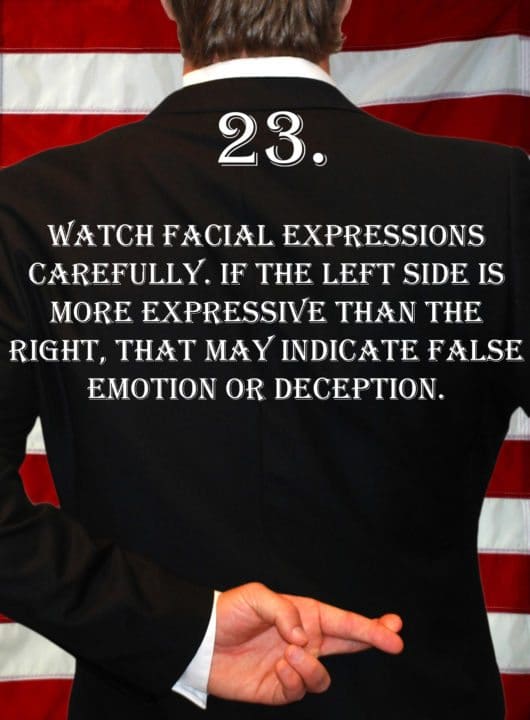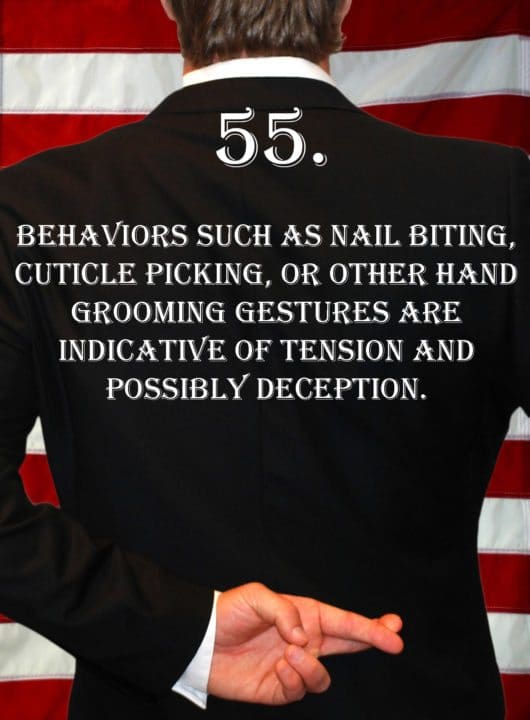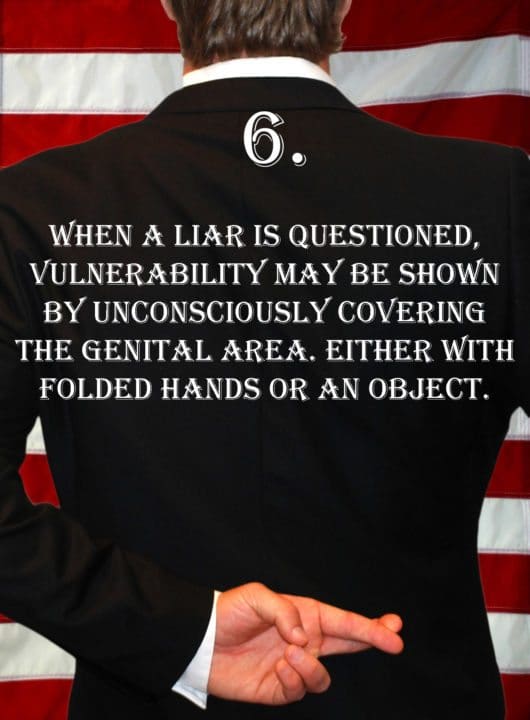
Deception Tip 23:
Watch facial expressions carefully. If the left side is more expressive than the right, that may indicate false emotion or deception.
Listen To The Podcast!
E23 – Left Side – Deception Tips Podcast – Click Here To Subscribe
Podcast Transcript
Hello and welcome to the deception tips podcast, where you will learn amazing cues to detect deceit that will help you to read people like never before- I’m your host, Spencer Coffman. Let’s get started.
Welcome to episode 23 of the Deception Tips Podcast. Thanks for tuning in, once again. Last time, we talked about a sign of deception that was similar to what we spoke about in episode 1. We talked about crossing the legs.
Now, we talked about the lower part of the legs- so, down by the shins and ankles. People can lock those ankles, and tuck them back under their chairs. Those legs will be in the form of an ‘x.’ It’s more of a warding off, blocking, shrinking, minimizing behavior.
In addition, it’s also a withholding, or a defensive gesture where when people do it, they may be withholding information. Like, they want to speak but they lock themselves up so they don’t say whatever they’re trying to say or whatever they think they should say.
In addition, it could be defensive because when they’re being attacked they make an ‘x’ to kind of ward off those accusations. Very, very similar to folding the arms in that gesture could mean many things. It could be defensive, withholding, or cold.
The crossing of the legs could mean they’re cold. Maybe they’re trying to curl up for more warmth to get the body closer together to conserve some heat. You never know. This is why you must look for other clusters and patterns of behavior.
As I mentioned, the crossing of the legs can be a cluster if they make an ‘x,’ they lock the ankles and tuck them under. Now they’re minimizing. They’ve crossed them. They’ve tucked them. That’s a bunch of things.
Same with folding the arms. When they fold their arms that’s making themselves smaller. That’s covering up could be a sensitive area of the body. It’s also be conserving, folding, and blocking. Those two signs, in and of themselves, are clusters and patterns of behavior.
However, they will often occur with other signs of leakage as well and it’s up to you to determine whether those other signs are indicative of deception, withholding, fear, anxiety, or whatever the case may be. So, always, always pay attention to them and then watch for follow-up signs or additional signs. Those are like the warning and then the rest will come later if you are paying attention enough to see it.
Today, we are going to talk about a facial expression. And, this is more of a general facial expression and we’ve hinted at it and discussed it a little bit already. So, you should be very well familiar with this.
We’re talking about the left side of the face. Now, in episode 14 where we talked about symmetrical expressions, I said something about how expressions should be symmetrical on both sides of the face.
They need to happen simultaneously, symmetrically. They should be even. You should be able to put one of those coloring book things- where you have half of the picture and then you’re supposed to draw the other half based on the other picture.
Oftentimes, when I was a kid I used to just fold it backward and just trace it. I’d say, “Oh look at that! I’m a good drawer!” But really, I wasn’t, so folding it in half backward is a nice little trick that you can do if you want to complete the coloring book.
Anyway, when you see symmetrical expressions, it’s often an indicator of truthful expression or truthful emotion. Both sides of the face are expressing evenly what is going on in the brain. That means both areas of the brain, both sides of the brain, and both hemispheres of the brain are lighting up and firing equally, so they’re expressing on the face equally. However, when you see things asymmetrically, with the exception of contempt, which we talked about in episode 19, that usually means people are being deceptive.
Now, usually, this asymmetricity happens more on the left side of the face. Why? Because the right cerebral hemisphere is more prevalent in human emotions than the left cerebral hemisphere that is more truthful. And, the left side of the brain controls the right side of the face. The right side of the brain controls the left side of the face.
This is why on the left side of the face, you tend to see more asymmetricity, or more expressiveness when a true emotion leaks on the right side of the face. It’s more of a masking gesture.
When I spoke about the research project I did in college, about detecting smiles, oftentimes you could see fake smiles were more prevalent on the left side of the face. This is because they would start out on the left side of the face as a fake smile then, perhaps, it turned into a better smile or a real smile, because it actually made the person laugh.
Or, they just carried up the right side of the face to try to match the left side, and then you could tell it was an uneven smile because the left side of the face will often be the precursor, or the starter, in most false emotions.
Oftentimes, when people try to fake a smile, you’ll see a little archaic smile start up on the left side first. So, here we go. Deception Tip 23: Watch facial expressions carefully. If the left side is more expressive than the right, that may indicate false emotion or deception. Here it is again. Watch facial expressions carefully. If the left side is more expressive than the right, that may indicate false emotion or deception.
Now, notice I said false emotion or deception. Not all false emotions are deception. Yes, it is deception in the fact that it is a false emotion, but it doesn’t mean that the person is lying.
For example, I could see something and smile and pretend to smile, but that doesn’t mean I’m lying about it. I’m just portraying a false emotion because I don’t really feel joy or happiness. Yet, I’m smiling to be polite.
Now, you could claim that that is a form of a lie and you would be right. It is. And that’s- some of the statistics that people get when they say the average person lies like 5–10 times in 15 or 20 minutes of conversation.
Some people say it’s even 5 times in 10 minutes of conversation which would be like a lie every minute. That is a lot of lies that happen, but they attribute that to all of the micro-expressions and false emotions that people see.
So, if you see a liar happening and they’re watching all of your micro-expressions and you fake a smile, they would count that as a form of a lie. This is something interesting because it’s a false emotion. You didn’t lie to hurt anybody but you maybe faked that emotion, so they count that as a lie. That’s where they get some of these statistics.
Other statistics maybe a little bit less. They say you’ll maybe lie like 5 times an hour. There are all kinds of statistics. You can look them up online. Get a better idea of how many times you lie, then pay attention to yourself. See how true some of that is for you. The point is- that everybody lies.
Everybody lies all the time whether it’s malicious, social, or polite is up to the judgment of the situation. We’ll talk a lot more about the symmetricality of emotions, the left side of the face, the right side of the face- all of this coming up after this.
Do you have a Facebook account? Of course, you do! Like the Deception Tips Facebook page and participate in some online discussion, read some more information, write a review, or simply say hello. Like the page today on facebook.com/deceptiontipsspencercoffman.
Facial expressions must be symmetrical. Everything must be symmetrical. We’ve hit this many, many times. Episode 14- symmetrical expressions. Episode 12- when we talked about simultaneous gestures, and how they must be congruent.
And also, we talked about symmetrical gestures in episode 16. Therefore, you need to be watching for symmetricality. Truthful expression, truthful signs of body language, and leakage will be symmetrical. With the exception, again, of contempt.
Now, remember, contempt is the only asymmetrical facial expression- or one of the only asymmetrical facial expressions. In addition, it is predominantly displayed on the right side of the face. This is because as we’ve said, hopefully, you remember, the left cerebral hemisphere is in control of the right side of the face and the left cerebral hemisphere is also more truthful than the right cerebral hemisphere.
This means, that if the left cerebral hemisphere is truthful and it controls the right side of the face, then you are going to see a lot more truthful expressions on the right side of the face.
Now, this isn’t always the case because most of the time truthful expressions are going to be symmetrical which means they will happen on both sides of the face. So, there’s a little bit of hang-up or a disconnect there, but in general, the right side of the face is going to be more truthful but they have to happen symmetrically with the exception of contempt. So, you’ll only see that one primarily on the right side of the face.
You may see a fake contempt, or one of those little archaic smiles, come up on the left side of the face because that is controlled by the right cerebral hemisphere, which is more dominant in false emotions. It is more of the tricky side of the brain.
It is the part of the brain that deals more with creativity, which is obviously where people come up with lies. They’re creative. They come up with those things out of the blue, out of all their spontaneous, or their planned creation.
The left side of the brain is more reasoning, logical, mathematical, etcetera. So, that is more of rules and order. Whereas, the right side is more free-spirited type which could be why-again, part of it that the right side is more deceptive is because of the need for more free-spiriting and fewer rules. And, the left side would be more truthful because that needs more rules, order, logic, et cetera.
So, those are some good generalizations for you to kind of keep in mind when you’re looking for signs of deception and behaviors because that will help you understand more of the reasoning behind them.
And, it will help you see more when you know why it’s happening, or how it’s happening. You understand more of the science behind some of the behaviors. Then you can see them, know what they mean, know where they’re coming from, etcetera.
So, make sure to watch facial expressions carefully. Now, this is very, very true with facial expressions. Although it’s true with the rest of the body as well because the left and right sides of the brain are not only contralaterally related to the face, they’re contralaterally related to the entire body with the exception of the sense of smell. That goes directly right up to the same side of the brain, but that’s a different point and it’s really nothing to do with deception.
So, pay attention to the whole body, obviously, because each one is contralaterally related. But, most specifically the facial expressions of emotion because most of that leakage is going to be displayed on the face. Now, you’ll have to be really good at spotting it within a second, or in a fraction of a second, but that’s where it’s going to be displayed first and then it will be masked.
So, oftentimes, you’ll see it expressed truthfully, which would be on the right side of the face- the micro-expressions that could happen- then you’ll see it on the right side of the face compensate with that with a false emotion.
So, a little flash of enjoyment might happen on one side of the face- on the left side, that would be false- on the right side, it would be true. So, if they have a little bit of contempt, let’s say, on the right, then they may throw a little smile up on the left and it may be a split-second difference. Or, if there is some form of surprise, then it will symmetrical on both sides- smiles will be symmetrical on both sides.
But, watch out for symmetricality and masking because that’s how it will be. And, oftentimes, when people mask an emotion, they’ll do an over-compensation on the left side of the face.
So, if there’s a little bit of a contemptuous or disgust smile, or disgust lip curl on the right side of the face, then the left side of the face will start to compensate and, oftentimes- let’s say they both go up to the bottom of the nose- well, the left side may go up a little higher because they’re trying to over-compensate to make up for that emotion in that masking.
So, then you’ll see it started out asymmetrical, because it started out truthful on the one side of the face, on the right. Then it happened falsely on the left side of the face. Then it continued on the left side of the face and became asymmetrical again.
So, it started off asymmetrical, became symmetrical, then overcompensated to become asymmetrical. So, the bottom line is, that you’re going to watch for symmetricality. You’re going to watch both sides of the face to determine where it started.
False emotions will start- most likely will start- on the left side of the face and then the right side may be consciously controlled to kind of symmetricality, or to try to get that so it looks more genuine and more real.
Obviously, in a false emotion, both sides of the face are going to participate, but the truthful side or the right side, is not going to believe that it is a true emotion just because the left side has started something.
It’s kind of funny because I talk about it as if they are two different entities that are kind of happening opposite of each other, or in existence with each other, and trying to work together, but they’re not. Really, it is the same entity and the same body that is happening, and all this, as I’m talking about it, it seems as like- this will happen, then this will happen, then it’ll be on this side, then it’ll be on this side.
We’re talking about all of this happening within less than a second or less than two seconds. Or, smiles that take like four seconds at a maximum. Anything longer is generally not true or it’s a prolonged smile or lasting which is only done for socially polite, etcetera.
But, all this stuff- one side of the face, the other side of the face, the other- then back to the other side. It all is within split seconds so you have to pay attention and watch it quickly because it’s not something that’s like a series of events that just unfolds over time.
I mean, it is a series of events and it does unfold over time, but it is a super, super short amount of time that, if you blink, you could miss it and it’ll be over. So, you won’t see that deception happening. You won’t see that expression taking place.
This is why it is so important to watch out for other signs of deception and behavioral clusters/patterns of behavior/etcetera because the more you watch, the more you’ll see, and the more you will be able to determine whether or not it is truth or lies.
I want to thank you for listening to this week’s episode of the Deception Tips Podcast. I encourage you to share it with your friends, subscribe to the feed, check out the Deception Tips blog, and take a look at the books I have available. And as always, tune in next week for a new Deception Tip.
Video Transcript
Hey guys, my name is Spencer Coffman. Thank you for watching the Deception Tips Videos, they’re all about teaching you how to read people and to detect deception so that you will be able to tell if someone is lying to you.
Today we’re going to talk about a cool facial expression. We’ve talked about it a couple times before in past videos, just kind of hinted on it, how the right cerebral hemisphere and the left cerebral hemisphere are contralaterally related to the face, which means they control opposite sides of the face. So the right brain controls the left side of the face and the left brain controls the right side of the face. Now it’s hemispheres, it’s not two separate brains, but you get the idea.
So today we are going to talk about how false expressions and false emotions are more predominant on the left side of the face. This is because they are controlled by the right brain, which is typically more dominant in false emotions.
So here it is, this is Deception Tip number 23: Watch facial expressions carefully. If the left side is more expressive than the right, that may indicate false emotion or deception.
So this is important for you because you want to watch, typically, as you’ve learned before, facial expressions are always symmetrical. Truthful facial expressions are always symmetric. With the exception of contempt, which is the only facial expression that is asymmetrical. That means it happens only on one side of the face. Now based on what I’ve just said and what you’ve learned, if the right side of the brain controls the left side of the face, and that is indicating in deception, but the left side of the brain controls the right side of the face, which is truthful emotion, where would you expect to see contempt? You would expect to see this on the right side of the face.
This is because the left side of the brain controls the right side of the face, which is truthful emotion. So that would be contempt, which would be on the right side of the face. Then the right brain would come in and kick into action and put an expression on the left side of the face to even out that contempt and turn it into a smile. That would be a deceptive behavior.
So you’d have the truthful emotion that would leak out, it would be a micro expression, really quick, come on the right side of the face then the left side of the face would come in with a masking expression, and even it out into a masking smile. So that’s what you need to watch for with this, is most of the time emotions, truthful emotions, are masked instead of concealed or withheld. Because it is very difficult to prevent yourself from being expressive.
If you like something, or if you’re happy, you smile. Now if you smile, but you don’t want to appear that you’re smiling, you may conceal that by turning it into something else. Or like when you yawn, do you ever yawn, and it’s kind of uncontrollable, you don’t know why you yawn, it just happens. Or if someone else yawns, it’s contagious and then you yawn. What you can do is, it’s a lot easier to either let that yawn just happen or to conceal it by kind of clenching your jaw. Now I wasn’t talking about it, you might even yarn, or I might yawn, because it’s going on in our minds. It’s a very weird thing, but it’s easier for you to conceal or mask that yawn then it is to stop that yawn from happening altogether.
In the same way, this is the same with emotions. It’s a lot easier to conceal or mask them than to stop them from happening altogether. So watch out for this. If you see smiles, or if you see other things on that come in on the left side of the face, then you need to watch and say, “did I miss some truthful expression that came just before that?” Now, this whole thing can play out in like one second. Now with smiles, it could be a little bit longer.
For example, we’ll run through a contempt situation where they would see contempt come on the right side of the face and that would happen for maybe like a quarter of a second, then the brain catches up and the right brain kicks in and moves that smile on the left side of face to try to even out that contempt. Because the contempt is sort of like a half of a smile, and then the right, left side would kick in and then after that, the left side may even kick in a little too high, so now the smile will be higher on the left than on the right. And then eventually, if something enjoyable happens, or if their brain kind of catches up, and they can convince themselves that it is a real smile, it could turn into a real smile. And now this whole thing could last for maybe two to four seconds.
So it’s very, very short. And it’s very brief, and if you catch it too late and you see the whole smile happening, now you may not know what came before it. But don’t worry, because there will always be more than one sign. Anytime someone is lying, they’re going to display leakage all over the place. It’ll be all over the face, all over the body, the legs, just pay attention to all of the behaviors. And if you see something that you question or that you kind of wonder if you missed something, now you can just kind of start focusing a little bit more and pay a little bit closer attention to determine if there are more signs that follow.
If not, then no big deal, but if there are, you will be watching to catch them and to know whether or not they are telling the truth. If this is your first time watching these videos, I would love to have you subscribe to the channel on YouTube. Also, if you have any questions or comments, feel free to leave them there as well. In addition, if you’d like some more information, we’ve got books, podcasts, blog posts, all available on SpencerCoffman.com that are 100% dedicated to teaching you exactly what every body is saying.
Until next time.






